Swedish Food for a Midwest Christmas
Pepparkakor, Lussekatter, köttbullar, glögg and open-faced sandwiches. These are some of the foods a Swedish julbord just can’t be without.
-
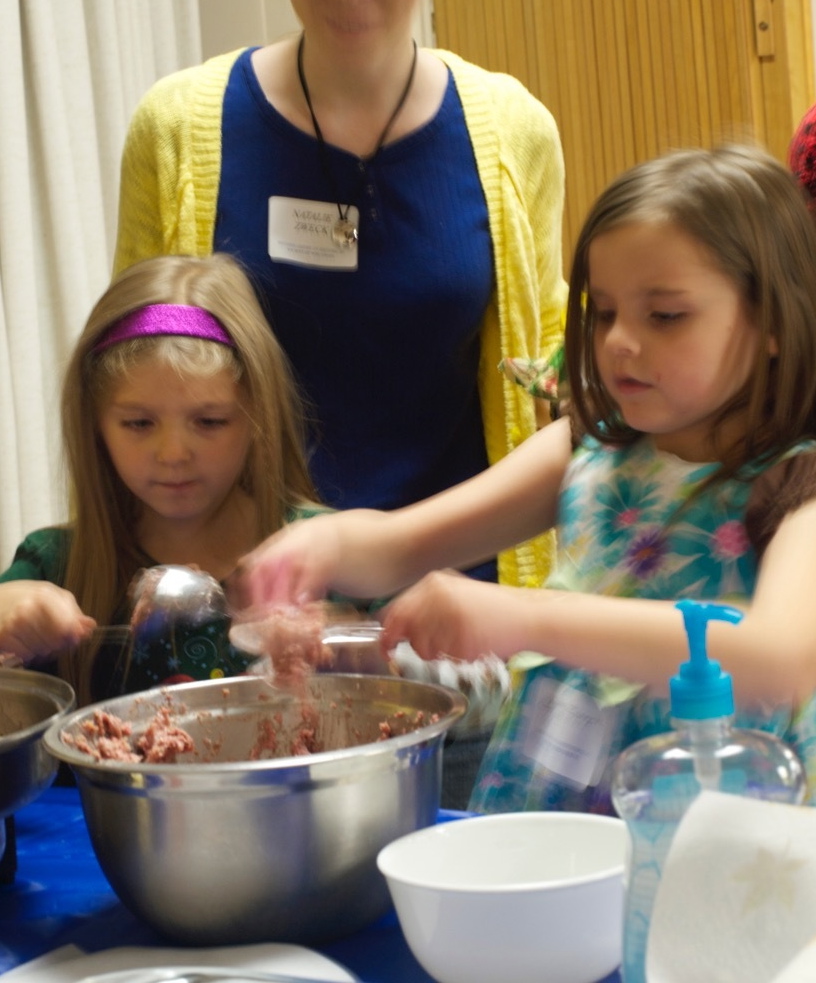 Liberty and Trinity Zweck, who love to help their mormor cook, form “Marika's kötbullar,” a recipe from the Hummel family cookbook from Stockholm.
Liberty and Trinity Zweck, who love to help their mormor cook, form “Marika's kötbullar,” a recipe from the Hummel family cookbook from Stockholm. -
-
In early November, members of the Swedish American Historical Society of Wisconsin demonstrated techniques and tips for making some favorite Swedish recipes to eager learners. Cooks brought ingredients so they could demonstrate how to make their specialty, and they brought plenty of already-made samples to share. Members of the SAHS and community at large got to try rolling the pepparkakor dough thin enough, taste the glögg-drenched raisins and almonds in the bottoms of their glasses, and lick their lips after savoring the meatballs they just made and fried in the skillet.
Event coordinator Sonia Hummel teamed with her mom Anne-Marie, a Stockholm native, at the köttbullar (meatballs) table. “The meatball recipe we used was that of my mom’s niece who still lives in Sweden. That recipe came from her mother and was passed down in her family.” Anne-Marie, who was talked into coming to the U.S. at age 20 to be a nanny with her friend, ended up staying and marrying an American.
She has tried many meatball recipes over the years, and has a couple favorites with different spices, including “Marika's köttbullar,” shared here. Sonia says she, too uses her family’s favorite Swedish Christmas food recipes. “My mom always had a great Christmas Eve smörgåsbord. Most of my family still carries on the tradition.”
Barbara Froemming, whose grandparents were Swedish, knows that no julbord would be complete without the open-faced sandwiches she showed the crowd how to make. “It is so much fun to make them when there are endless variations of ingredients possible and they always add interesting colors and flavors to the food selections.” According to her cookbook, open-faced sandwiches can be enjoyed as finger food or with a knife and fork.
Marianne Ekstrand, who moved with her brother and parents to the U.S. from Sweden when she was 10, admits to having several favorite glögg recipes. “During Christmas, my mom cooks the wine with oranges and cinnamon, and sometimes with vodka, too.” But the non-alcoholic version Marianne made for this occasion is similar to the kind that can be bought in stores and heated at home. It has spices in it, and wine can be added according to preference. She reminisces: “Glögg and ris a la malta (rice pudding) are my favorites to drink and eat at Christmas time; it wouldn't be the same without them.”
Liza, Marianne’s mom, served the Lussekatter (saffron buns). Although she doesn’t recall her mother making Lussekatter in Sweden (“maybe because it was easy to get them from a bakery”), the recipe she used is one from her mother’s old "kokbok” (cookbook). Liza, who came from Malmö in southern Sweden’s province of Skåne, had them made ahead of the demonstration because they take about four hours to make. But it’s worth the effort. “I love the saffron flavor, and to take the time to make them at least once a year,” she says. It’s not surprising that her favorite time to do so is around Lucia.
At the ginger snaps (pepparkakor) table, Denise Herzog said the trick to making it paper-thin is to roll it out on a pastry cloth with a really flowered-up rolling pin sleeve. And when it's the thickness of a potato chip, or you can see the cloth through the dough, then it's thin enough. Pat shared her Swedish mother's recipe, which, given personal experience as I lightly pressed on a few cookies in the palm of my hand, bring very good luck: They each broke into three pieces. That's a great harbinger for this season's round of holiday baking! -
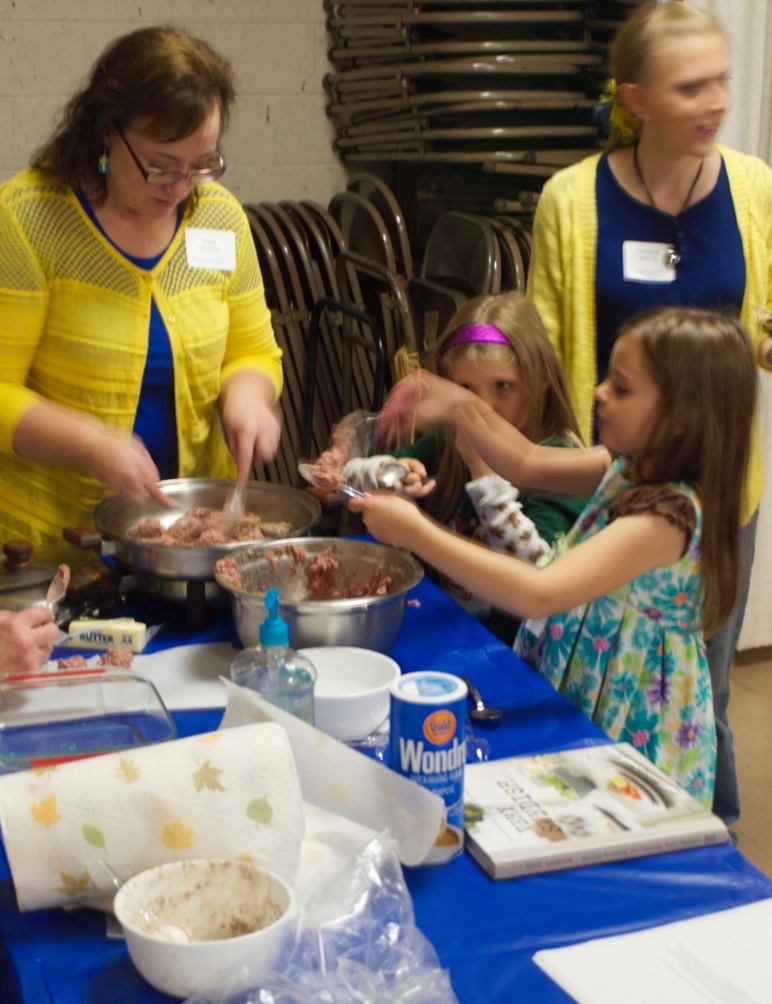 Sonia Hummel demonstrated how to make her mom Anne-Marie's favorite kötbullar (meatballs) recipe with Liberty (5) and Trinity (7).
Sonia Hummel demonstrated how to make her mom Anne-Marie's favorite kötbullar (meatballs) recipe with Liberty (5) and Trinity (7). -
-
MARIKA'S SWEDISH MEATBALLS (köttbullar)
1½ cups soft bread crumbs
1 cup half-and-half
1 tablespoon butter
1 cup chopped onion
1½ pounds lean ground beef
¼ pound lean ground pork
1 egg
1½ teaspoon salt
½ teaspoon ground ginger
1 tablespoon ground all spice -
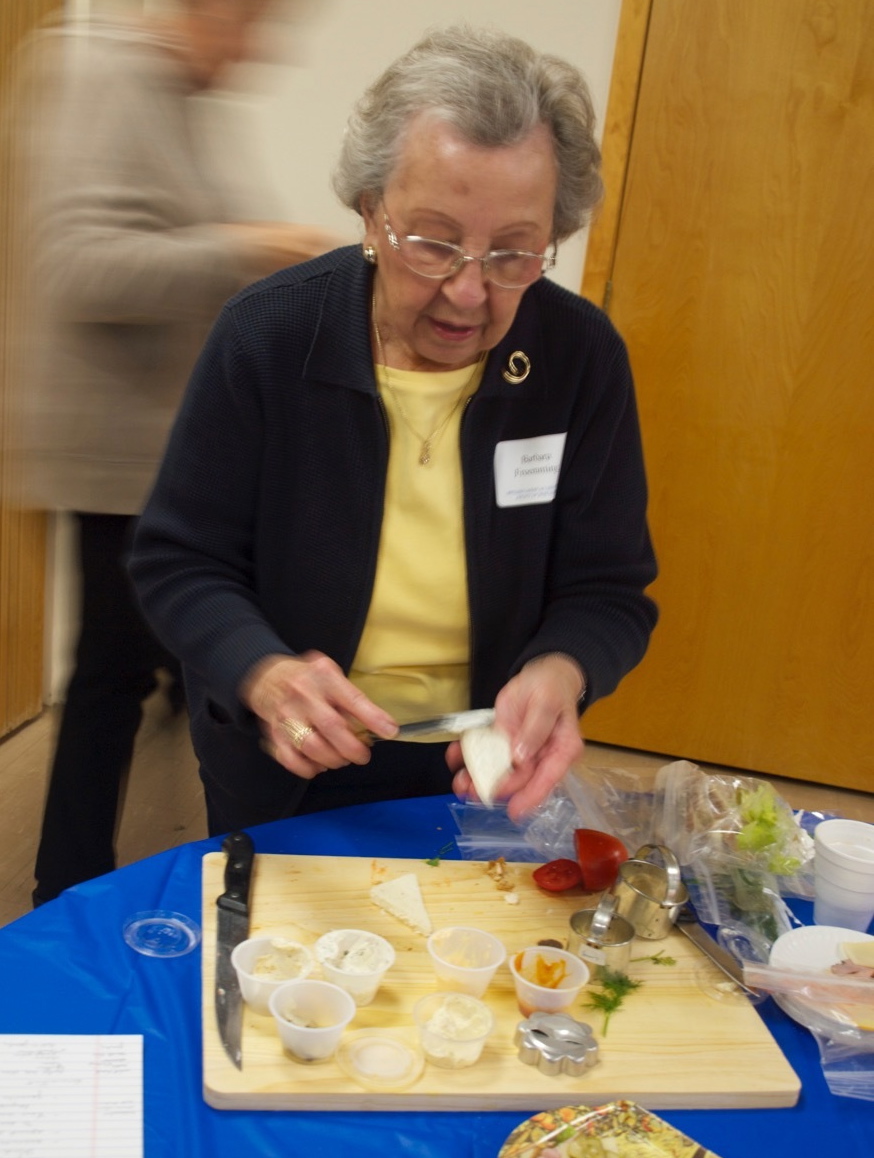 Barbara Froemming makes open-faced sandwiches with her favorite ingredients.
Barbara Froemming makes open-faced sandwiches with her favorite ingredients. -
For gravy:
2 tablespoon butter
2 tablespoon all purpose flour
Cream with drippings -
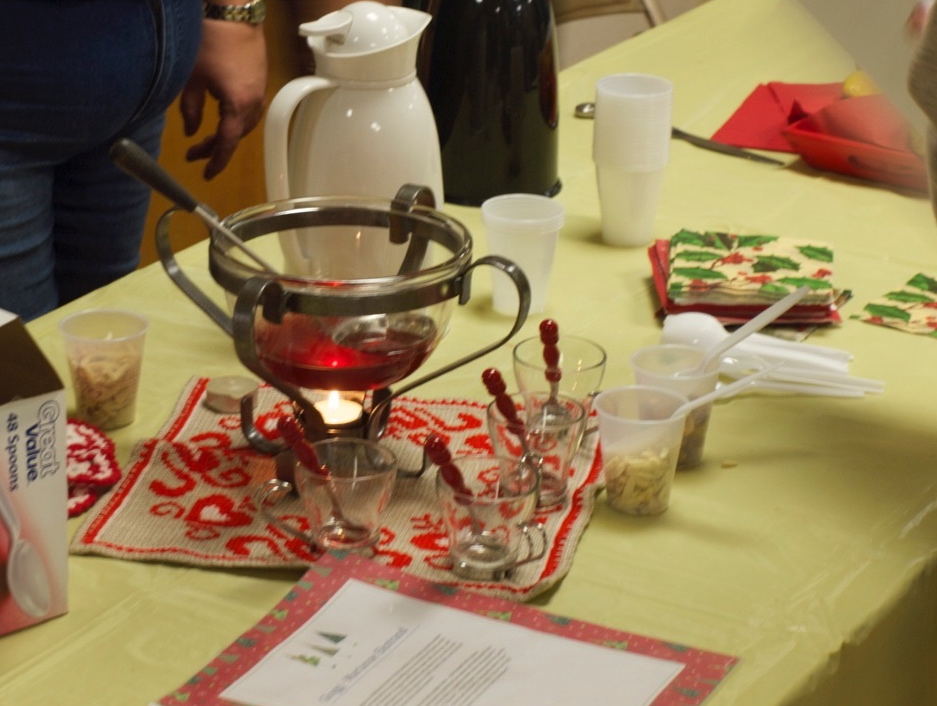 Warm, spicy glögg is delicious in all its many versions — with or without alcohol, with spices, oranges, almonds and even tea.
Warm, spicy glögg is delicious in all its many versions — with or without alcohol, with spices, oranges, almonds and even tea. -
In large bowl of electric mixer, soak breadcrumbs in half-and-half with spices for 10 minutes. Melt 1 tablespoon butter in a large skillet over medium heat. Add onion, sauté until soft, about 3 minutes. Stir into breadcrumb mixture. Add beef, pork, egg, salt, ginger, allspice. Beat at high speed until mixture is fluffy.
Dip 2 teaspoons in ice water until cold. Use cold spoons to shape meat mixture into tiny balls. Fry in butter until brown then bake in oven on low heat until cooked.
Stir flour into drippings in skillet. Gradually whisk in cream. Continue stirring until mixture thickens. Return meatballs to sauce in skillet. Simmer 15 minutes or until meatballs are heated through.
Makes 4 to 6 servings or 48 meatballs. -
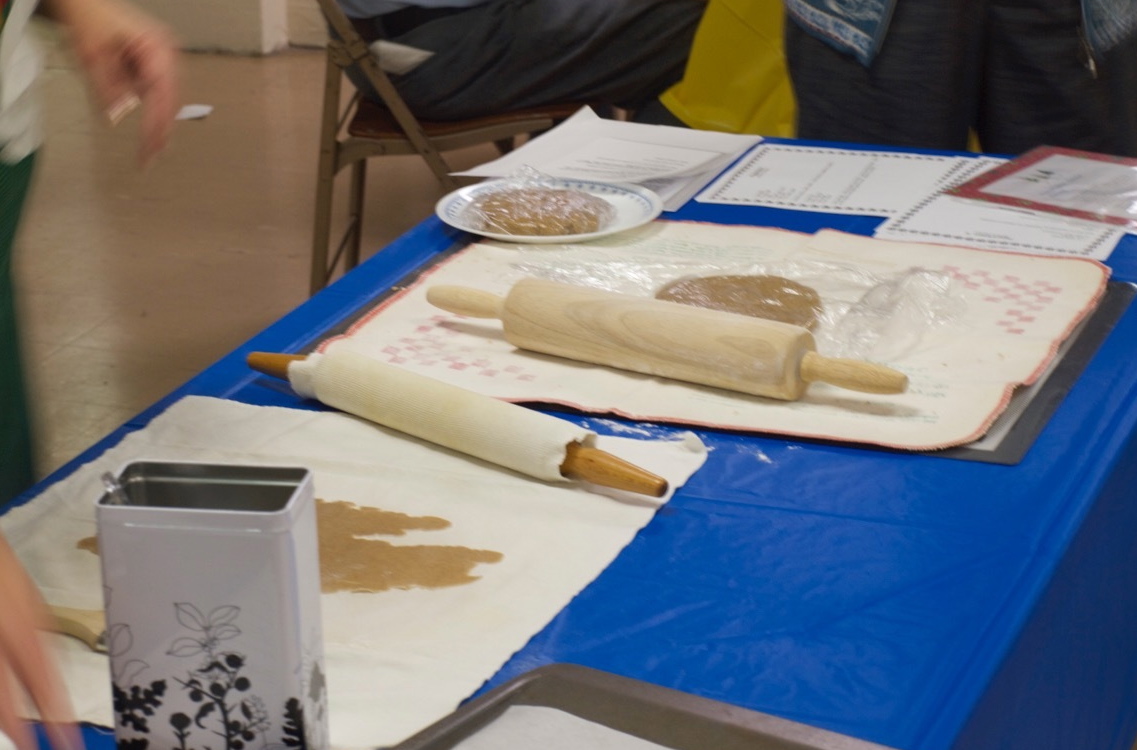 Participants got to try rolling the pepparkakor dough thin enough, which meant they had to see the cloth through the dough. Baker Denise Herzog said she wouldn't eat the pepparkakor if it wasn't thin enough.
Participants got to try rolling the pepparkakor dough thin enough, which meant they had to see the cloth through the dough. Baker Denise Herzog said she wouldn't eat the pepparkakor if it wasn't thin enough. -
OPEN-FACED SANDWICHES (Smörgåsar)
Use compact loaves of homemade or commercial bread that hold their shape when cut. Dark breads, firm pumpernickels or firm French bread are best. Slice bread about ½ inch thick.
Arrange slices of bread on a flat surface. Butter each slice, covering all edges to prevent moist toppings from soaking through. Cut each piece twice on the diagonal to create four triangles.
Add thinly sliced fish, meat or vegetables to all slices of bread before adding the next topping or garnish: red and green vegetables, fruits, radish slices, parsley springs, watercress, bean sprouts, tomato pieces or wedges, onion rings, cucumber twists, orange or lemon twists.
-Pumpernickel bread with cream cheese, thinly slices salmon, paper thin cucumber round.
-French bread with mayonnaise or butter, dried dill, shrimp tomato wedge, parsley
-Pumpernickel bread with butter, sliced egg, Swedish caviar, parsley -
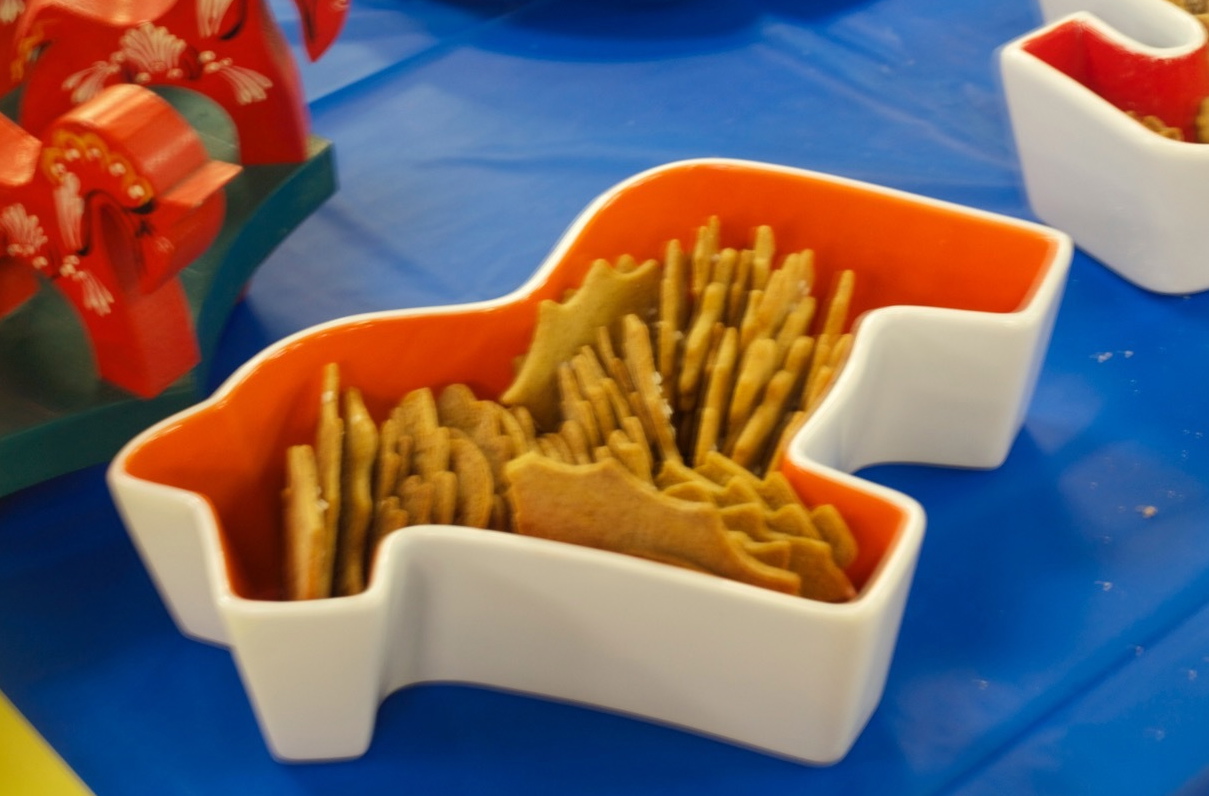 Pepparkakor shows off its importance on the holiday table in a Dala horse bowl.
Pepparkakor shows off its importance on the holiday table in a Dala horse bowl. -
FRUIT JUICE GLÖGG (saft glögg )
1 medium orange
1 quart apple cider
2 cups white grape juice or currant juice
¼ cup sugar -
1 (3-inch) cinnamon stick
8 whole cloves
⅔ cup raisins
⅔ cup slivered blanched almonds -
Using a vegetable peeler, cut colored portion from orange in a single spiral. Reserve orange for another purpose.
In a large pot, combine orange peel and remaining ingredients. Let stand 4 hours. Bring to a boil over medium heat. Reduce heat to low; simmer 30 minutes.
Serve hot (or cold) in punch cups, including some raisins and almonds in each serving.
Makes 12 servings. -
LUSSEKATTER
1 cup melted butter
½ teaspoon saffron threads finely crumbled (or 1 teaspoon powdered saffron)
1 cup milk
¾ cup sugar
1 teaspoon salt
2 packages dry active yeast (4½ teaspoons)
6½ cups all purpose flour
2 eggs + 1 egg white, well beaten
Raisins or currants to decorate -
Crumble saffron threads into melted butter. Let sit 30 minutes to an hour (this intensifies the saffron flavor). Heat milk to a light boil, turning off heat when it reaches the scalding point (with small bubbles across the top). Stir in melted butter, sugar and salt.
Pour mixture into bowl and allow to cool until finger-warm (quite warm but just cool enough to touch). Stir in yeast and let sit for 10 minutes.
Mix 3½ cups flour into the liquid. Stir in 2 well-beaten eggs. Add enough of the remaining flour to form a soft dough (just until the dough pulls away from the sides of the bowl. You don’t want too much flour).
Transfer dough to a large greased bowl and turn to coat all sides. Cover with a clean towel and allow to rise until doubled, about 1½ hours.
Punch down dough. Lightly knead two or three times on a floured surface. Punch off small handfuls of dough (about the size of a racquetball) and roll into snakes. Shape snakes into S-shaped buns or other desired shapes.
Place on a lightly greased baking sheet. Cover with towel again and allow to rise until doubled (about an hour).
Decorate with raisins, brush with egg white and bake in preheated oven 375˚F about 10-15 minutes just until brown. -
GINGER SNAPS (pepparkakor)
¾ cup butter
¾ cup firmly packed brown sugar
1 tablespoon cinnamon
2 teaspoons ground ginger
1½ teaspoons ground cloves
1 teaspoon baking soda
¼ cup boiling water
2½ cups flour -
In a large bowl, cream the butter and sugar until blended. Add the spices.
In a separate bowl, combine the baking soda and boiling water, then add to the dough along with the flour. Mix to make a stiff dough. If necessary, add more water, one tablespoon at a time. Chill for 30 minutes.
Preheat oven to 375˚. Line baking sheets with parchment paper. Roll the dough on a pastry cloth to a ⅛-inch thickness. Cut into pig, heart or any shaped cookies that measure about 2 inches.
Place on the prepared pans and bake for 7 to 10 minutes, until lightly browned.
Yields approximately 60 cookies. -
-
